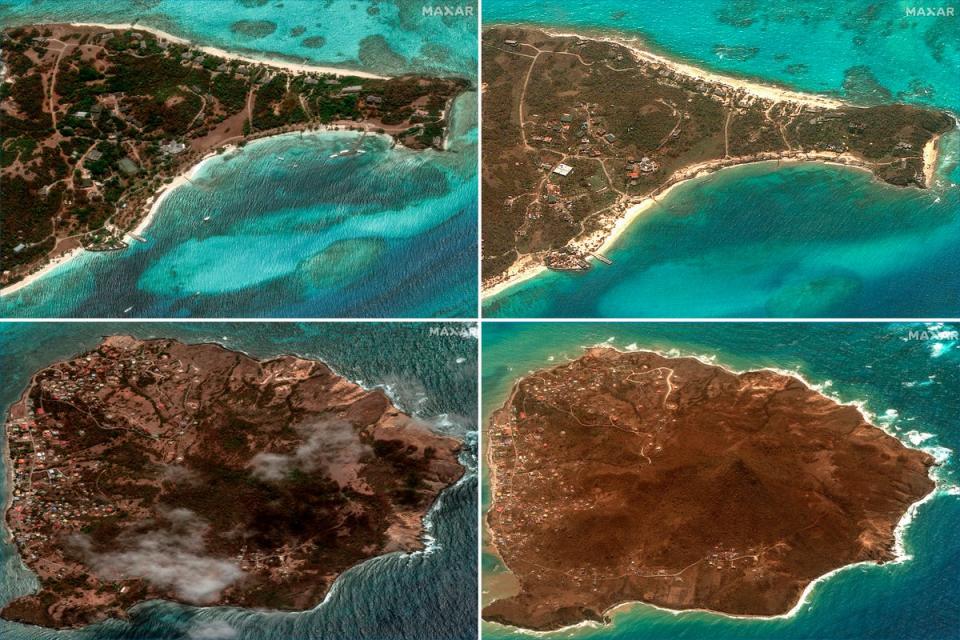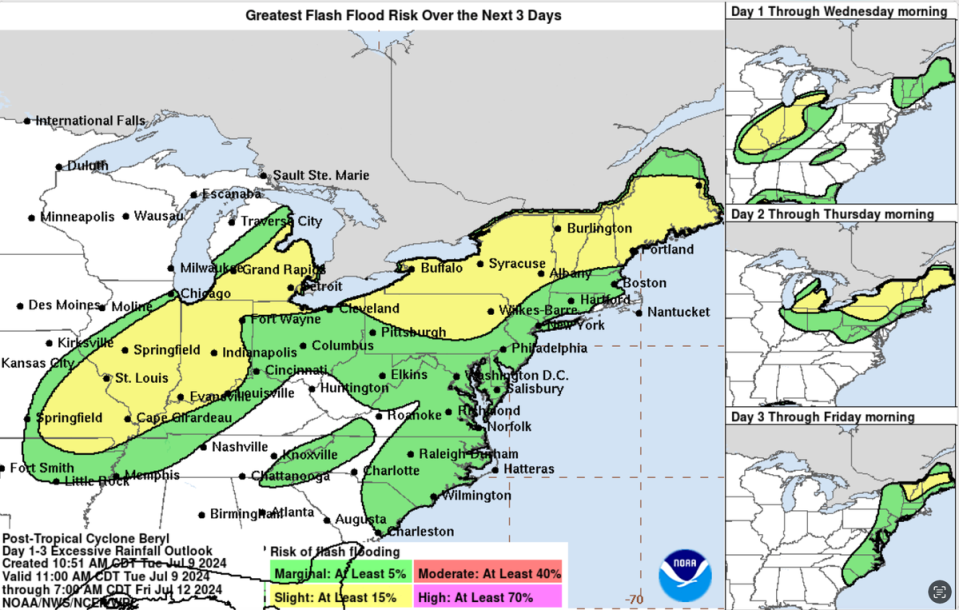Hurricane Beryl may have caused up to $32bn worth of damages and losses in the United States, according to preliminary figures by an independent organisation.
Beryl, which made landfall in Texas as a Category 1 hurricane on Monday after churning across the Caribbean and Mexico, has caused widespread flooding, power outages and damages to infrastructure.
At least seven people have died in the Houston region as a result of Hurricane Beryl, according to city and county officials. Earlier, 10 people died in the Caribbean.
A preliminary estimate by AccuWeather, a private weather forecasting company, shows these damages in the US alone could account for between $28-32bn.
This estimate includes direct and indirect costs and damages to homes, businesses, infrastructure, facilities, roadways, and vehicles, as well as power outages resulting in food spoilage, job and wage losses, flight delays, and interruptions to medical care, etc.
“Beryl will go down in the history books as a record-shattering hurricane,” said AccuWeather’s chief meteorologist Jon Porter.
“It was the earliest Category 5 hurricane on record in the Atlantic basin, causing catastrophic damage in the Windward Islands. Beryl brought impacts to Jamaica and the Cayman Islands before slamming into the Yucatan Peninsula of Mexico with damaging wind and storm surge.”
AccuWeather’s damage estimate accounts for both insured and uninsured losses and is based on a variety of sources, statistics, and unique techniques, the company said in a statement. It also includes an estimate of the potential damage it can cause as it moves up inside the US.

Beryl, now a tropical rainstorm, is expected to continue causing flooding, localised tornadoes, and gusty winds as it moves through the Midwest, Great Lakes, and into central and northern New England.
In Texas, heat and humidity were also significantly impacting recovery efforts. More than two million homes and businesses across southeast Texas have been without power for over 24 hours since Beryl made landfall. Extended power outages were likely to last several days in the hardest-hit communities.
To put the damages from Beryl in context, last year Hurricane Idalia, which made landfall into the Big Bend of Florida, caused $18-20bn in total damage and economic loss. Hurricane Ian, in 2022, caused $180-210bn. Hurricane Harvey, which impacted a similar area in Texas, caused $230bn in total damage and economic loss in 2017.
Meanwhile, leaders across the Caribbean were also worried about the economic impact of Beryl after it left a trail of destruction on Jamaica and islands of the eastern Caribbean.
Officials were still tallying the financial toll from the storm that hit them when it was at its maximum Category 5 strength.

“There is no doubt this disaster will have a major impact on Grenada’s economic situation,” prime minister Dickon Mitchell told a briefing on Tuesday.
“We are talking hundreds of millions of dollars in losses and hundreds of millions of dollars to rebuild.”
Grenada’s Carriacou and Petite Martinique islands face “almost complete devastation,” he added, saying people who lost their homes were particularly vulnerable to the elements.
Mr Mitchell said there is a need to rebuild structures resistant to storms, adding that many of the country’s existing wood houses are not insured.
A team of insurers is set to arrive on Wednesday and the government plans to announce fiscal measures by early next week.
St Lucia posted early estimates of close to $2m from damages including buildings, sea moss harvests and banana plantations.
Rainfall and debris hindered assessments in Jamaica, whose agriculture sector initially reported over $6m in damages.
CARICOM chair Mohammed Ali said many long-term crops were lost and farmers would face issues for years to come in a “heart-breaking” initial assessment for agriculture, according to Reuters news agency.

Small islands face the highest risks as hurricanes continue to intensify and become more frequent due to man-made climate crisis, despite producing very little carbon pollution compared to big economies.
Hotter sea waters, which are caused due to harmful greenhouse gases produced by burning oil, coal and gas, fuel hurricanes.
This year, ocean heat in the Atlantic in July was already at par with the levels seen ususally in September, the peak season for hurricanes, resulting in Beryl becoming the earliest ever Category 5 hurricane.
“Record high ocean heat content, primarily caused by climate change, clearly played a role in the rapid intensification of Beryl across the tropical Atlantic, eastern Caribbean, and the Gulf of Mexico before it encountered wind shear, drier air, and the added friction from land masses,” AccuWeather climate expert and senior meteorologist Brett Anderson said.
In fact, Beryl intensified twice, the second time when it came near Mexico and the US, due to bath-tub warm waters near the coast.
“As Beryl got within 100 miles of the Southeast Texas coast, it passed over a pocket of very warm sea surface water that was at least 86 degrees,” Mr Anderson said.
“This increase in temperature provided just enough additional energy to help Beryl strengthen to a Category 1 hurricane before it made landfall.”
“Fortunately, Beryl was still moving along at a steady clip. If Beryl had slowed down, that would have allowed it to spend more time over the very warm waters and potentially strengthen to a Category 2 or even a Category 3 hurricane.”
Caribbean countries have been demanding more action from wealthy polluting nations like the United States, European countries and China to rapidly decarbonise. International negotiations have also been taking place for financial support mechanisms for smaller countries to deal with disasters.
A loss and damage fund, which can support the island nations, is up for negotiations again at the upcoming United Nations climate summit in Baku, called Cop29, in November.
However, climate financing measures have so far remained highly inadequate to meet the costs from rising disasters and have funnelled billions of dollars back to rich countries, leaving poorer countries in debt.
Last 13 months have been the hottest on record for the planet with intense heatwaves, heavier rainfall on the land and boiling waters fuelling storms.
Meteorologists are forecasting an explosive hurricane season this year due to record ocean heat.
AccuWeather says 20-25 named storms could be seen this year and 4-6 could potentially have direct impacts on the US.
“You don’t want to wait too long to restock your hurricane supplies, and most importantly, don’t let your guard down at all this hurricane season,” Mr Porter said, adding that they are forecasting “a very busy and impactful hurricane season, and we’re just getting started.”
EMEA Tribune is not involved in this news article, it is taken from our partners and or from the News Agencies. Copyright and Credit go to the News Agencies, email news@emeatribune.com Follow our WhatsApp verified Channel





